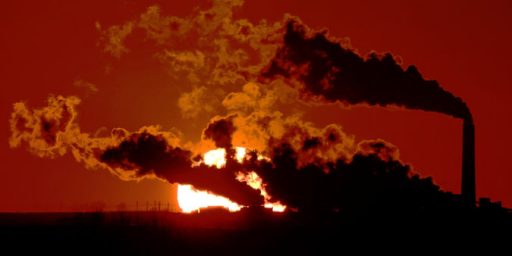The Heresy Begins
Unlike many of my political ilk, I favor taking an aggressive approach to environmental protection, provided that it’s done using the markets or a market mechanism. Global warming is one issue where I favor us stepping up and doing something to reduce the amount of CO2 emissions. New nuclear reactors should be part of the solution, which means removing the accumulated roadblocks that prevent plants from coming online. Kyoto should not be part of the solution.
Instead, I favor the U.S. creating its own caps for CO2 emissions and its own market for trading the pollution rights. The market could be linked to other markets if desirable, but control over the caps should remain in U.S. hands alone. That way we could determine how much CO2 abatement is tolerable, because it will come with a cost, though with an active market it could provide guidance for innovation and be a net creator of wealth and jobs. It’s a stretch, but it is possible.
In addition, I would insist, were I the king, that some form of geoengineering be pursued. One promising example is the Geritol Solution. The reason I would insist on a form of geoengineering is that reducing current emissions won’t reduce the accumulated CO2 currently in the atmosphere. Without a component that actually solves the problem, we are left with Bjorn Lomborg’s scenario where we delay maximum temperature by six years after having wasted trillions of dollars. In short, we would end up with nothing.
In spite of me dissing Kyoto — I object to being bound by a treaty, not to using a cap-and-trade system — it’s worth looking at some of the progress that’s occurred in Europe since CO2 trading began last year (Financial Times, $):
The ETS marks a paradigm shift in European environmental policies — engaging with the private sector in searching for the most cost-effective solutions to a global problem. It is the first international trading system and the world’s largest in terms of economic coverage.
For European businesses, tackling carbon dioxide emissions is changing from being solely an issue for the environmental department to being a part of overall corporate planning. Companies across the EU are now beginning to establish carbon management systems, where monitoring and reporting, production data and commodity trading desks are being linked together.
With emission trading, the EU has created a new currency based on tonnes of CO2 and a new market in emission allowances. The fluctuations we have seen over the past few weeks are not unusual for a new market, as experience with similar markets in the US shows. The fluctuations were a response to the first release of verified data and these data will be taken fully into account for the second phase.
Overall, the first year of operation has been a success. During 2005, an estimated 260m allowances were traded with a financial value of more than €5bn. The Commission is convinced emission trading must remain at the core of EU climate policy and that market mechanisms provide a successful long-term response to climate change.
The same could be true for us even without Kyoto. As the Euroweenies are wont to remind us, we are the largest emitter of CO2 on the planet. We also have the largest economy on the planet, making it quite feasible for us to develop a thick market in tradeable pollution credits and allow the producers that are least capable of reform buy the most credits. The producers that can reduce CO2 emissions at the lowest marginal cost would be in a position to benefit.
One qualification to the above: though I admit to thinking that global warming is real and partially man-made, I don’t buy into Algore’s doomsday scenario and ten-year “tipping points”. If there is any truth to that at all, it’s simply because geoengineering is being overlooked.






If you can get those volcanos that spew out more greenhouses gasses than all the countries of the world combined signed up, then you might be on to something.
I suppose your next post will be promoting “creation theory” and other junk science?
Actually, I’m a hard core evolutionist. The first sentence of yours is barely coherent. Care to re-state?
Sunspots reaching 1,000-year high.
By Dr. David WhitehouseBBC News Online science editor.
The Sun is more active now than it has been at anytime in the previous 1,000 years. Scientists based at the Institute for Astronomy in Zurich used ice cores from Greenland to construct a picture of our star’s activity in the past. They say that over the last century the number of sunspots rose at the same time that the Earth’s climate became steadily warmer.